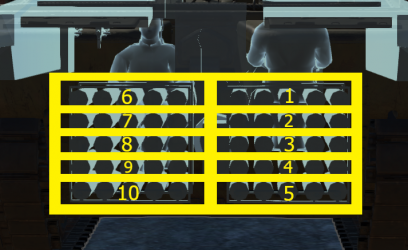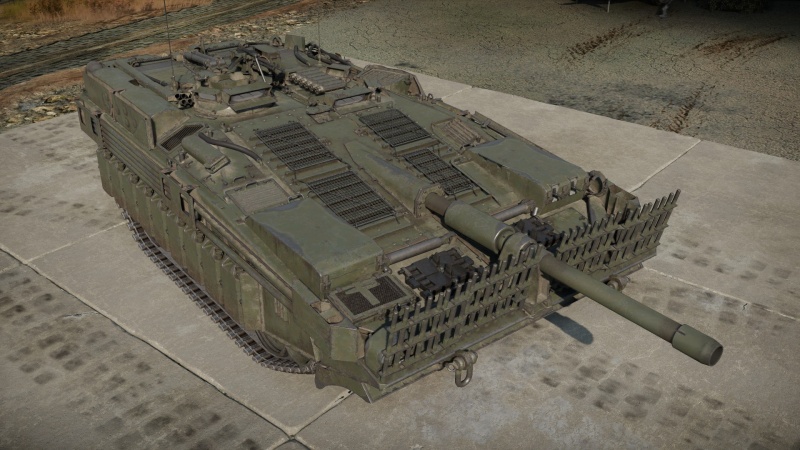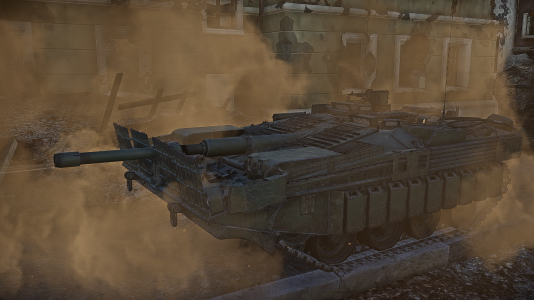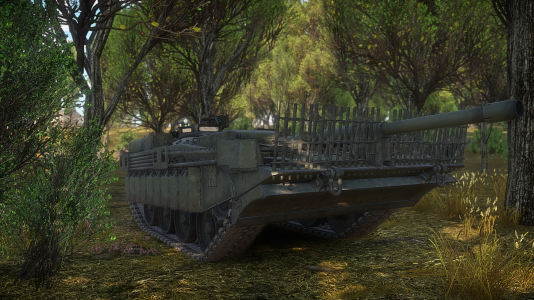Strv 103C
| This page is about the Swedish medium tank Strv 103C. For other versions, see Strv 103 (Family). |
Contents
Description
The Stridsvagn 103С was the final production variant of the S-tank family. In defense decision 1982, it was planned to withhold acquiring new tanks, which meant the existing tanks and the Strv 103s had to undergo renovations. The vehicles were improved with a better Detroit Diesel engine for better manoeuvrability, a laser rangefinder integrated with the gunner sight for better distance accuracy, and built-in dozer blade on all Strv 103Cs for better protection of the lower front of the hull, as well as side skirt protection to improve the overall survivability of the vehicle.
The Strv 103C was introduced in Update 1.97 "Viking Fury". An improved version over the Strv 103A with better manoeuvrability, better and modern shells, and lastly improved survivability with a fence at the front to protect the hull from HEAT and HEAT-FS rounds, side skirts were added to improve side protection as well. Being a hull-aim based vehicle makes its low silhouette easy to hide behind low cover, also able to use the hydraulics to peek over small hills without exposing too much of itself and take a quick shot then go back into hiding and either manoeuvre to a new position or hope the enemy vehicle did not notice from where the Strv 103C fired from so it can take another peek and fire again. The Strv 103C, like the preceding Strv 103A, has a fast reloading 105 mm gun and can fire every four seconds to hit with a rapid devastating fire on unaware enemies.
General info
The Strv 103C is a Swedish MBT with a unique design compared to all other tanks of the same era. The S-tank, as it is more commonly known, makes use of the hull to direct fire at various targets. This feature requires the unique "Enable Hull aiming" key, which turns the tank from its regular cruising mode, into a fixed turret, capable of aiming wherever the player points their cursor. The reason the Strv 103C made use of hull-aimed weaponry becomes apparent when looking at the armour. The Strv 103C has armour sloped back more than 75 degrees, giving it strong frontal protection, with a high likelihood of causing enemy shells to ricochet. Another luxury a hull-fixed gun offers is the use of an automatic loading system. The Strv 103C can fire its main 105 mm cannon every four seconds, no matter the amount of crewmen left. Paired with high mobility, and the Strv 103C becomes one of the most unique main-battle tanks in the game. With a bit of ingenuity and patience, the Strv 103C works at all ranges, in almost all conditions imaginable.
This isn't to say the Strv 103C is without flaws. The tank is incredibly vulnerable to flanking manoeuvres, as the side and rear have a thickness of 30 mm. It usually doesn't matter what kind of vehicle gets behind the Strv 103C, as even SPAA has no issues penetrating the tank. The gun is also filled with drawbacks, especially relating to the aiming. Due to hull-aiming relying on the ground below it, aiming becomes increasingly difficult on uneven terrain as the tank tries to compensate for things in the way. This results in shaky, and highly inaccurate aiming at longer ranges. The tracking is also bad, as the tank finds it difficult to adjust the speed at which it steers neutrally. This requires a Strv 103C tanker to wait for the target to cross its line of sight, instead of following it along its path. The armour is incredibly weak against APFSDS rounds and ATGM missiles. These usually have enough penetration to knock the tank out in a single blow, exploding the ammunition in the rear as a final touch. As these types of munitions are quite common at this tier, the Strv 103C can't rely on armour against most opponents on the battlefield. A positive is that weaker types of munitions usually can't reach the crew compartment, resulting in the Strv 103C surviving 3-5 shells before dying from engine fires.
Survivability and armour
External survivability
The Strv 103C is outfitted with incredible frontal protection. This strong impenetrability isn't thanks to composite, but rather sloping. The Strv 103C has an incredible frontal slope of over 75 degrees. This results in a lot of ricochets from outdated types of munition, which lack significant velocity to damage the tank. Chemical rounds, which penetrate high amounts independent of velocity, have a higher likelihood of penetrating the vehicle. These shells don't bounce off as easily, while still carrying large penetration values. In order to counter this, the Strv 103C was outfitted with a unique external armour package. Commonly referred to as a "HEAT fence", the Strv 103C is able to counter upper-plate detonations by fusing them ahead of the armour itself. This hinders chemical rounds from causing heavy post-penetration damages, which increases frontal impenetrability. The lower plate has also been strengthened by the introduction of a dozer blade. This adds an extra 20 mm of angled armour, which comes handy against stronger types of munition. The sides have also been slightly enhanced by the introduction of 5mm fuel-canisters acting as side skirts.
Internal survivability
Once a shell penetrates the vehicle, the Strv 103C has to rely on its layout. Since the S-tank is entirely hull-designed, everything is incredibly compact to accommodate its varying features. The engine is placed at the front of the vehicle, followed by the crew compartment and lastly ammunition storage. When a frontal penetration occurs, a tanker can consider these compartments as varying grades of damage. Engine penetrations are usually fine, as the only way to take the tank out is by igniting it several times. Shells reaching the crew compartment can be severe, as the tank only has 3 members. Thanks to the last-stand feature, only one member needs to be alive. This can result in a lot of tanked hits, since it's difficult for the enemy to locate which member is still left. Finally, the Strv 103C is usually destroyed in a single hit if the post-penetration is strong enough to reach the rear ammunition storage. A tanker can still luck out if the shell penetrates the left-side when carrying 26 rounds, as only the right side will be filled.
A universal strength is the upper ribbed armour package. Previously introduced on the Strv 103A, this package allows the Strv 103C to "shred" incoming projectiles. Thanks to the introduction of volumetric shells, no subcalibre round can currently sneak through this package. Due to heavy angling, and being placed behind the fence itself, it reaches thickness levels of between 500 and 1200mm, making it one of the strongest armour layouts in the game.
A universal weakness is slightly above and below the sharp edge where the upper and lower plate meets. This area can be easily penetrated by both chemical and conventional rounds. With varying damage depending on post-penetration effect. Aiming below the gun-barrel can also knock it out in the process, leaving the Strv 103C incredibly vulnerable.
Armour type:
- Rolled homogeneous armour
- High hardness rolled armour - Slat
| Armour | Front (Slope angle) | Sides | Rear | Roof |
|---|---|---|---|---|
| Hull | 40 mm (77°) Upper Glacis 40 mm (74°) + 20 mm Lower Glacis |
30 mm +10-20 mm Upper 30 mm Lower |
30 mm | 20 mm |
| Cupola | 35 mm | 35 mm | 35 mm | 20 mm |
Notes:
- Tracks are 20 mm thick while the suspension is 15 mm thick.
- Slat armour is 50 mm thick.
- Sideskirts are 4 mm thick.
- The crew compartment is lined with 10 mm RHA.
Mobility
| Game Mode | Max Speed (km/h) | Weight (tons) | Engine power (horsepower) | Power-to-weight ratio (hp/ton) | |||
|---|---|---|---|---|---|---|---|
| Forward | Reverse | Stock | Upgraded | Stock | Upgraded | ||
| Arcade | Expression error: Unexpected * operator. | 1057 | Expression error: Unexpected round operator. | __.__ | |||
| Realistic | 690 | Expression error: Unexpected round operator. | __.__ | ||||
When glancing over the stat-card of the Strv 103C, it can be easy to assume the tank has inferior mobility to the earlier variants. But thanks to the tank utilizing the turbine in tandem with the more powerful diesel engine, it ends up being one of the most powerful engines at its BR. This catches a lot of opponents off-guard, as they generally don't expect the Strv 103C to be able to change positions quickly. This can also surprise wounded opponents, as they usually think they're safe hiding behind smaller obstacles without the Strv 103C coming towards them. And when facing opponents lacking any form of subcalibre munitions to deal with the Strv 103C, a tanker can find enjoyment scaring them by simply charging at their position.
The Strv 103C suffers from a severe lack of turrets, which makes it vulnerable to bad positioning. Turreted tanks can easily deal with enemies coming from the sides, without exposing a lot of weak spots. The Strv 103C needs to turn the entire vehicle, which often proves fatal. To avoid this, it's important to practice driving in reverse. The Strv 103C goes almost top-speed in both directions, making it viable to drive in reverse if the tank requires immediate repositioning. Combining this with smoke-grenades makes it impossible for the enemy to predict where the vehicle currently is.
Modifications and economy
Armaments
Main armament
The Strv 103C is outfitted with the Bofors L74 105 mm cannon. This cannon is identical to the earlier versions of the S-tank. There is some slight visual differences, as the cannon is now welded to the chassis, rather than just drilled through on the earlier variants. But the main difference lies in the ammunition. The Strv 103C gets access to the DM23 subcalibre shell. This is a treat at its BR, as not all tanks get access to it. The Strv 103C benefits greatly from this upgrade, as shots don't require the same amount of precision as before to land a devastating hit. This makes it more forgiving to aim, which is especially helpful with the sometimes janky hull-aiming a tanker may experience. But to compensate even further, the Strv 103C features the same autoloader as any other S-tank, allowing it to fire up to 50 shells with a mere 4-second interval between each round. This makes the Strv 103C the fastest firing DM23 tank in the game, allowing for some incredible killing sprees when positioned correctly.
| 105 mm L74 | Turret rotation speed (°/s) | Reloading rate (seconds) | ||||||||
|---|---|---|---|---|---|---|---|---|---|---|
| Mode | Capacity | Vertical | Horizontal | Stabilizer | Stock | Upgraded | Full | Expert | Aced | Autoloader |
| Arcade | 50 | -10°/+12° | N/A | N/A | 33.6 | 33.6 | 40.8 | 45.1 | 48.0 | 4.00 |
| Realistic | 21.0 | 21.0 | 25.5 | 28.2 | 30.0 | |||||
Ammunition
| Penetration statistics | |||||||
|---|---|---|---|---|---|---|---|
| Ammunition | Type of warhead |
Penetration @ 0° Angle of Attack (mm) | |||||
| 10 m | 100 m | 500 m | 1,000 m | 1,500 m | 2,000 m | ||
| slpprj m/66 | APDS | 272 | 269 | 258 | 246 | 233 | 222 |
| slpprj m/80 | APFSDS | 337 | 335 | 330 | 322 | 314 | 306 |
| slsgr m/61A | HE | 23 | 23 | 23 | 23 | 23 | 23 |
| Shell L35 | HESH | 127 | 127 | 127 | 127 | 127 | 127 |
| Shell details | ||||||||||||
|---|---|---|---|---|---|---|---|---|---|---|---|---|
| Ammunition | Type of warhead |
Velocity (m/s) |
Projectile mass (kg) |
Fuse delay (m) |
Fuse sensitivity (mm) |
Explosive mass (TNT equivalent) (kg) |
Ricochet | |||||
| 0% | 50% | 100% | ||||||||||
| slpprj m/66 | APDS | 1,450 | 4.53 | - | - | - | 75° | 78° | 80° | |||
| slpprj m/80 | APFSDS | 1,455 | 4.2 | - | - | - | 78° | 80° | 81° | |||
| slsgr m/61A | HE | 680 | 15.5 | 0 | 0.1 | 1.83 | 79° | 80° | 81° | |||
| Shell L35 | HESH | 720 | 11.4 | 0.1 | 4 | 3.15 | 73° | 77° | 80° | |||
| Smoke shell characteristics | ||||||
|---|---|---|---|---|---|---|
| Ammunition | Velocity (m/s) |
Projectile mass (kg) |
Screen radius (m) |
Screen deploy time (s) |
Screen hold time (s) |
Explosive mass (TNT equivalent) (g) |
| rökgr m/61 | 330 | 18.7 | 20 | 5 | 25 | 50 |
Ammo racks

| Full ammo |
1st rack empty |
2nd rack empty |
3rd rack empty |
4th rack empty |
5th rack empty |
|---|---|---|---|---|---|
| 50 | 46 (+4) | 41 (+9) | 36 (+14) | 31 (+19) | 26 (+24) |
| 6th rack empty |
7th rack empty |
8th rack empty |
9th rack empty |
10th rack empty |
Visual discrepancy |
| 21 (+29) | 16 (+34) | 11 (+39) | 6 (+44) | 1 (+49) | No |
Note:
- Shells are modeled individually and disappear after having been shot or loaded.
Machine guns
| 7.62 mm ksp 58 | ||||
|---|---|---|---|---|
| Mount | Capacity (Belt) | Fire rate | Vertical | Horizontal |
| Coaxial | 500 (250) | 600 | N/A | N/A |
| Coaxial | 500 (250) | 600 | N/A | N/A |
| Pintle | 1,500 (250) | 600 | -10°/+30° | ±180° |
Usage in battles
Long-range Maps
A natural fit for the Strv 103C is long distance engagements. With its high fire-rate and fast shell, paired with unmatched optics and laser rangefinder, it has all the tools to dominate opponents at longer distances. The Strv 103C should be spawned as early as possible, swiftly positioned far ahead of the team, with plentiful amounts of cover to compensate for its lacklustre survivability against subcalibre munitions. Since the tank has incredible mobility, and almost impenetrable frontal protection in hull-down positions, the S-tank creates hell for the enemy team, forcing them to strategically flank the vehicle, or attack it with guided missiles. The gun barrel can still get knocked out, forcing the Strv 103C to back away for a few seconds to repair. This can prove costly however, as this window of opportunity can be wide enough to allow a flanking manoeuvre by the enemy team.
Having teammates substantially increases the tank's survivability against flanking opponents, as a turreted teammate can easily engage enemies trying to sneak a final shot in.
Close-range Maps.
Realizing the upsides and downsides of the Strv 103C makes it clear the vehicle was never designed for close-range engagements. This downside does show its truth as the vehicle can't fire on the move effectively, and is forced to take it slow in order to not get blasted from the side in a single shot. Either way, these maps can't be ignored when spading the vehicle, or when trying to research its more conventional brother, the Strv 104. Despite its flaws, the many upsides still have a lot of usage in closer engagements, and can result in high kill games, despite the uncomfortable surroundings. At the start of a match, the mobility should still be used to its limits. The Strv 103C only really gets to move freely without any form of danger at the beginning of the match where opponents haven't yet secured any areas of the map, so it's important to take a good position as early as possible. Hiding behind buildings and corners is highly effective, as getting flanked won't occur as often. The tank can very effectively fight off one enemy at a time, but struggles to focus on several opponents at once, due to the lack of a conventional turret. This forces the Strv 103C to pick off targets when they're busy with something else. Alternatively, if the Strv 103C sees opponents incapable of effectively penetrating its frontal protection, it can calmly peek out of cover to attack, without any danger, as even if the barrel gets damaged, the tank can swiftly reverse back at max speed.
Having a coordinated teammate can prove devastating for the enemy team, as a turreted teammate can easily fend off opponents from directions the Strv 103C can't handle. Thanks to the tanks amazing survivability, the Strv 103C can coordinate with a lesser armoured teammate, to work as a spearhead against incoming shells. As soon as the Strv 103C gets crippled, a teammate can easily jump in to deal with the distracted opponents. Since the Strv 103C needs to repair a lot due to commonly sustaining damage, having a teammate that can lower repair times is incredibly helpful.
| Always smoke when you get immobilized in the Strv 103C! After smoking you can angle the tank vertically with the use of hull-aiming, making it difficult for the enemy to deal more damage. |
Pros and cons
Pros:
- Improved shell choice over the predecessor
- In favourable terrain and positioning it can become difficult to spot and penetrate
- New HEAT "fence" - Counters most Chemical rounds
- Strong turbine engine - Gives the tank high mobility & good off-road performance
- Low silhouette - Capable of hiding behind walls and small hills
- Excellent optics - 18X zoom
- Dozer blade can create cover if none is readily available
- Can be controlled by one crew member
Cons:
- When caught exposed it can be easily penetrated by most of the MBTs, making the tank very situational
- Unusually compact interior makes any penetrating shot much more devastating
- Gun is prone to damage
- Unable to fire while moving
- Poor stock performance - Weak stock rounds and slow acceleration
- Loud turbine & diesel engine - Difficult to silently hide
- Hull aiming is hard to use
History
Strv 103C is the last official series of the S tank, in the army decision 1972 and 1982 it was decided that getting a new tank for the army was going to be postponed to the 1990s and the Swedish army at time would focus on lighter combat vehicles. So to modernize the S tanks, the Strv 103Bs had to go through a renovation with upgrading the systems and improve the vehicles in a so called REMO (Renovation and Modification) process and it was not until 1986 the first Strv 103B got its REMO done and was designated Strv 103C.
In the Renovation and Modification process the Strv 103Bs got upgraded from a Rolls Royce piston engine to a Detroit Diesel engine, dozer blade on all "S" Tanks that used to be only 1 of 3 Strv 103s equipped with that, new tracks, new external fuel tanks in the form of 22 litre jerry cans that were attached on the sides that also worked as extra protection to the side armour, laser rangefinder that was integrated with the aimsight for the gunner, Lyran 71 mm illuminating mortar and new gearbox.
It was not until 1988 that all 290 Strv 103Bs had been renovated to Strv 103C where they stayed in service until 1997 the Strv 103 saw the last of its service in the armed forces.
Devblog
In the immediate postwar years, Sweden began looking for a replacement to the Centurion tanks, then in service with its army. The most straightforward solution was to once again look into the export market for potential candidates, although engineers were already working on a domestic design - the Kranvagn. While this process was ongoing, an engineer by the name of Sven Berge came up with a radical new tank design in 1956.
This new vehicle featured a turretless design with a cannon fixed to the hull, which would be trained onto its targets with the precise use of an adjustable suspension system. The design was based on results from a study on tank crew casualties during WWII and the Korean War, which showed a correlation between tank height and hit probability. As such, the 'S-Tank' was kept very small in dimensions and low in profile, while also utilizing some innovative new engineering solutions, such as a mixed power plant consisting of a diesel engine and a gas turbine.
In 1959, the Swedish government approved the construction and testing of two prototypes. In 1960, a pre-production batch of 10 vehicles of the '0-serie' was ordered for field trials, which went on into the mid '60s. Generating more than favorable test results, the vehicle was formally ordered into production and procured as the 'Stridsvagn 103'.
Despite its original purpose being to replace the Centurion tanks in the Swedish Army, the Strv 103 ended up serving alongside it for a number of decades, until it was ultimately decommissioned in the late 1990s. By that time, 290 Strv 103s were built, spanning over five variants.
Media
- Skins
- Images
- Videos
See also
Links to the articles on the War Thunder Wiki that you think will be useful for the reader, for example:
- reference to the series of the vehicles;
- links to approximate analogues of other nations and research trees.
External links
| AB Bofors | |
|---|---|
| MBTs | |
| Strv 103 | Strv 103-0 · Strv 103A · Strv 103С |
| Tank Destroyers | SAV 20.12.48 · Bkan 1C |
| SPAA | Lvkv 42 |
| Radar | VEAK 40 |
| SAM | ASRAD-R* |
| See Also | BAE Systems AB |
| *Saab Bofors Dynamics | |
| Sweden medium tanks | |
|---|---|
| Strv m/42 | Lago I · Strv m/42 EH · Ikv 73 · Strv m/42 DT · Pvkv IV |
| Centurion derivatives | Strv 81 · Strv 81 (RB 52) · Strv 101 · Strv 104 · Strv 105 |
| Strv 103 | Strv 103-0 · Strv 103A · Strv 103С |
| Strv 121/122 | Strv 121 · Christian II · Strv 122A · Strv 122B PLSS · Strv 122B+ |
| Other | Sherman III/IV · T 80 U |
| Finland | |
| WWII | ▄T-28 · ▄T-34 · ▄Pz.IV · ▄T-34-85 |
| Post War | ▄Comet I · ▄Charioteer Mk VII · ▄T-54 · ▄T-55M · ▄T-72M1 · ▄Leopard 2A4 · ▄Leopard 2A6 |
| Norway | Leopard 1A5NO2 |







